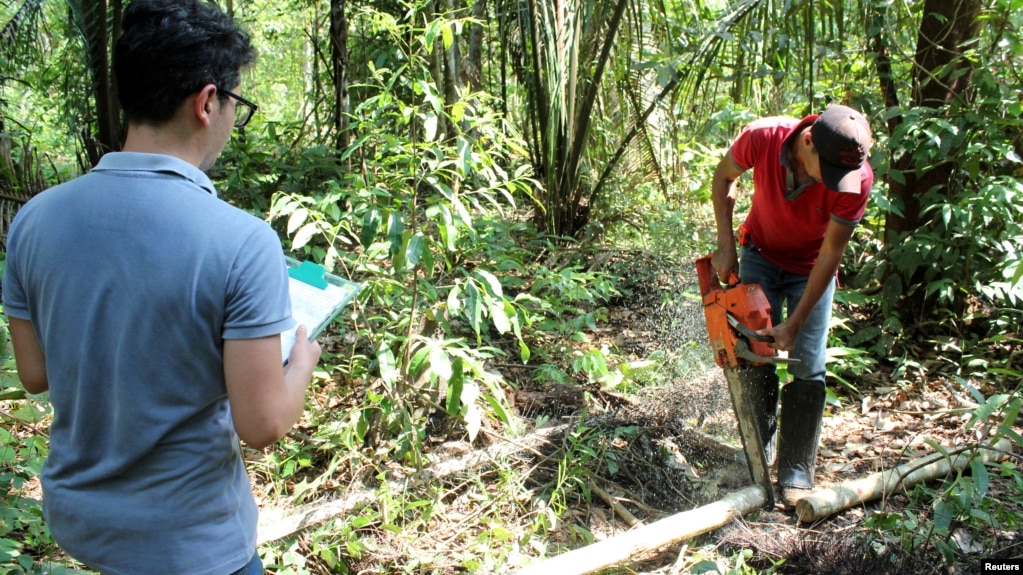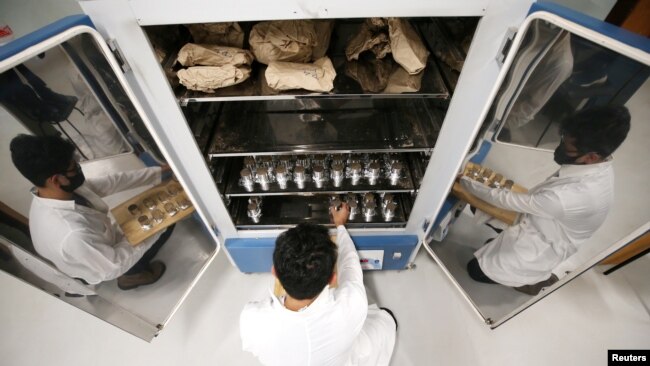
Forestry student Mateus Sanquetta observes as day laborer Ilandio Pereira da Silva cuts down a tree in the Amazon to measure its carbon levels in Itapua do Oeste, Rondonia state, Brazil November 4, 2020. (REUTERS/Jake Spring)
A small group of scientists carried machetes through the Amazon Rainforest. They cut through dense plant life as the mid-morning temperature rose above 38 Celsius.
The group of men and women cut into trees. They dug into the soil and painted words across tree parts.
“It’s destructive, but we only do it for a few trees,” said Carlos Roberto Sanquetta. He is a forestry engineering professor at the Federal University of Paraná in Brazil.
Sanquetta led the weeklong research trip in November. The team of scientists included a botanist, agronomist, biologist and other forestry engineers. They took several samples of plants, both living and dead.
The Brazilian researchers are studying how much carbon different parts of the world’s largest rainforest can store. Such storage can help remove carbon, a greenhouse gas, from the atmosphere. Greenhouse gases trap heat in the earth’s atmosphere.
The scientists are working in a part of the forest about 90 kilometers from Porto Velho in Rondônia state.
“We need to understand what is the role that forests play,” said Sanquetta, a member of the U.N. Intergovernmental Panel on Climate Change. The panel is the world’s top group of climate science experts.
Sanquetta said it is important to know how much carbon the Amazon’s trees take in when unharmed and how much they can release when destroyed.
In the rainforest, it is hard work, in hot, wet conditions filled with insects. And it involves use of several tools for cutting, digging and measuring.
Raoni Rajão specializes in environmental management at the Federal University of Minas Gerais. He is not involved with Sanquetta’s team but said, “These are hardworking people [willing to] get their hands dirty.”
Holistic methods
The Brazilian team is just one group among hundreds of researchers seeking to measure carbon in the Amazon rainforest. The massive forest covers more than six million square kilometers in nine countries.
Some research seeks only to measure carbon in trees, but Sanquetta says his team’s effort is all-inclusive. It measures carbon in soil, underbrush and dying plant matter. In addition, his team is studying carbon in reforested areas. This can offer information needed to push for reforestation efforts.
Carbon dioxide, or CO2, is the most widespread of the greenhouse gases. Trees take it in from the atmosphere and store it as carbon.
But the process also works the other way. When trees are cut down or burned, the wood releases CO2 back into the atmosphere. In Brazil, parts of the Amazon are often cut to make room for agriculture and grassland for cows.

Brazilian forestry student Mateus Sanquetta separates material collected in the Amazon to check how much climate-warming greenhouse gas a small plot of the rainforest can contain at the Federal University of Parana in Curitiba, Brazil, December 1, 2020.
Deforestation in the Amazon has sped up under President Jair Bolsonaro. Since he took office in 2019, at least 825 million tons of CO2 have been released from deforestation in the Brazilian Amazon. That is more than is released by all U.S. passenger cars in a year.
The office of Brazilian Vice President Hamilton Mourão leads the government’s Amazon rainforest policy.
In a statement, the office said the rise in deforestation happened before the current leadership. It also said the government has been working hard to end destructive mining and lumber trafficking.
Measuring carefully
Central to dealing with the climate threat is the need to improve carbon measuring methods for more exact readings.
“Everyone wants this information,” said Alexis Bastos, project leader of the nonprofit group Rioterra Study Center. The Brazilian organization provides financial support and several scientists to Sanquetta’s team, which began its current line of research in 2016.
What they know so far
Early findings show that planting a mix of Amazon species leads to better carbon storage than letting the area regrow naturally.
But the findings also suggest that nothing is better than leaving forests untouched.
One hectare of untouched Rondônia forest holds an average 176 tons of carbon, based on Sanquetta’s examination of Brazilian Science Ministry numbers. By comparison, a replanted hectare of forest after 10 years holds about 44 tons, and soy farms hold an average of only two tons.
After the work, the samples were taken back to the laboratory. There, the team dried and weighed them, before burning them. This lets them measure how much carbon is contained.
The team measured samples from 20 pieces of land in November. The final goal is 100 pieces of land by later in 2021.
The work could tell us “how quickly the planet could be healed,” Rajão said.
I’m Alice Bryant.
Reuters news agency reported this story. Alice Bryant adapted it for Learning English. Bryan Lynn was the editor.
____________________________________________________________
Words in This Story
machete – n. a large, heavy knife that is used for cutting plants and as a weapon
sample – n. a small amount of something that gives you information about the thing it was taken from
role – n. a part that someone or something has in a particular activity or situation
management – n. the act or process of deciding how to use something
panel – n. a group of people with special knowledge, skill, or experience who give advice or make decisions
underbrush – n. plants, bushes, and small trees growing under larger trees in a forest
lumber – n. wooden boards or logs that have been sawed and cut for use
species – n. a group of related animals or plants that is smaller than a genus
Comprehension Quiz
What happens when trees are cut down or burned?